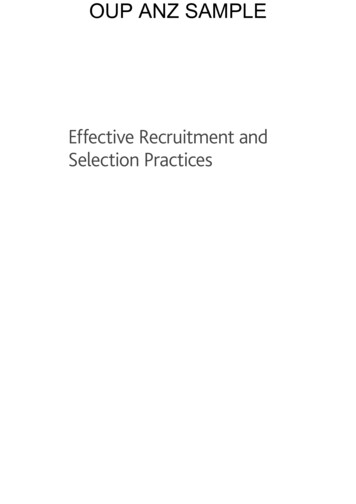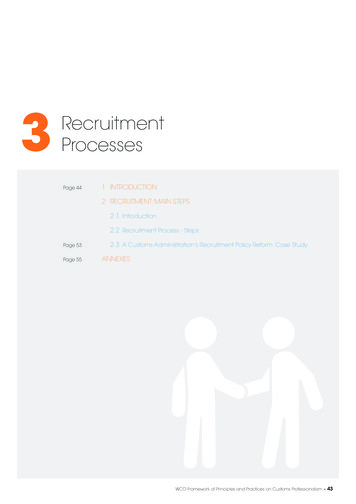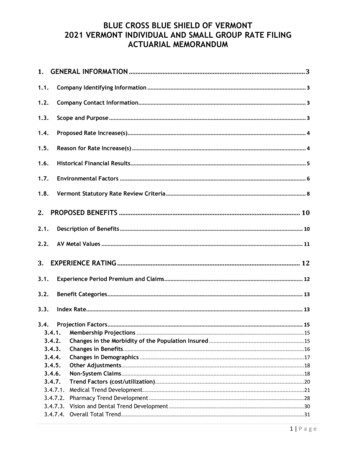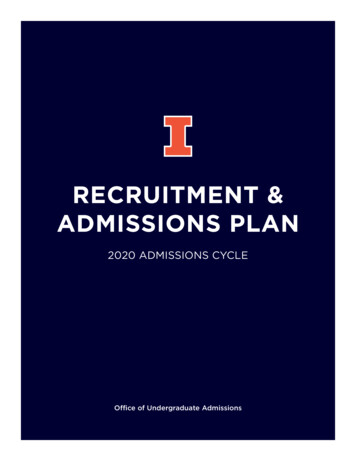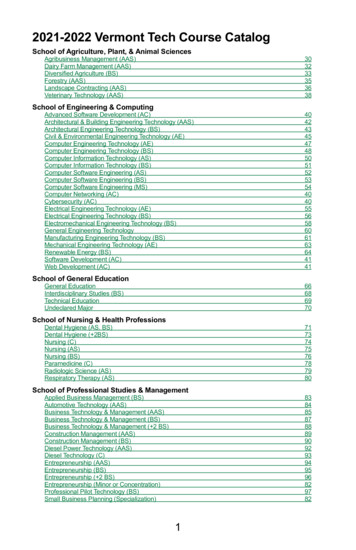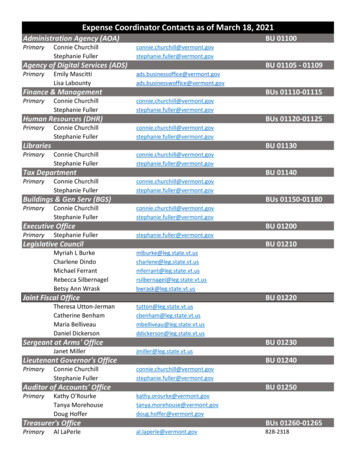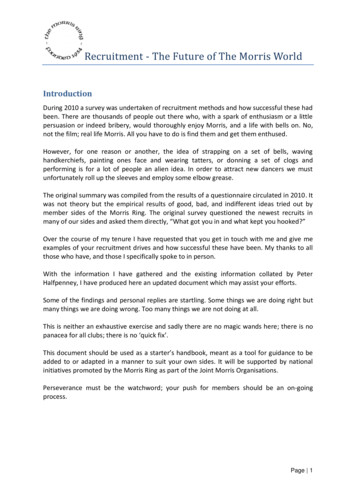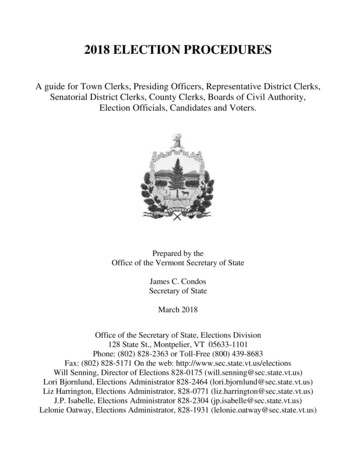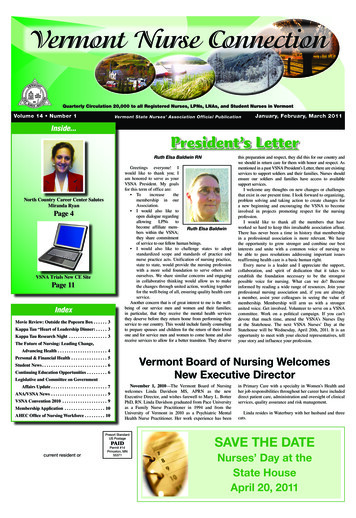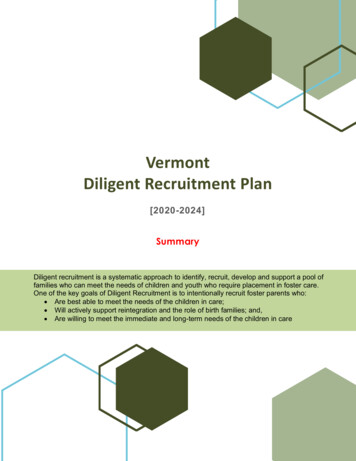
Transcription
VermontDiligent Recruitment Plan[2020-2024]SummaryDiligent recruitment is a systematic approach to identify, recruit, develop and support a pool offamilies who can meet the needs of children and youth who require placement in foster care.One of the key goals of Diligent Recruitment is to intentionally recruit foster parents who: Are best able to meet the needs of the children in care; Will actively support reintegration and the role of birth families; and, Are willing to meet the immediate and long-term needs of the children in care
2020-2024 Vermont Diligent Recruitment PlanI. Context and BackgroundUnderstanding Diligent RecruitmentDiligent recruitment is a systematic approach to identify, recruit, develop and support apool of families who can meet the needs of children and youth who require placement infoster care. One of the key goals of Diligent Recruitment is to intentionally recruit fosterparents who: Are best able to meet the needs of the children in care; Will actively support reintegration and the role of birth families; and, Are willing to meet the immediate and long-term needs of the children in careThe Multi-Ethnic Placement Act (MEPA) of 1994, as amended, prohibits the delay ordenial of any adoption or placement in foster care due to the race, color, or nationalorigin of the child or the foster or adoptive parents. It also requires States to provide fordiligent recruitment of potential foster and adoptive families who reflect the ethnic andracial diversity of children for whom homes are needed. To meet MEPA’s diligent effortsrequirements, States must have a comprehensive plan that includes: A description of the characteristics of waiting children; Specific strategies to reach all parts of the community; Diverse methods of disseminating both general and child-specific information; Strategies for assuring that all prospective parents have access to the homestudy process, including location and hours of services that facilitate access byall members of the community; Strategies for training staff to work with diverse cultural, racial, and economiccommunities; Strategies for dealing with linguistic barriers; Non-discriminatory fee structures; and Procedures ensuring a timely search for prospective parents awaiting a child,including the use of exchanges and other interagency efforts, provided that suchprocedures ensure that the placement of a child in an appropriate household isnot delayed by the search for a same race or ethnic placement.Key Information: The Structure of Child Welfare in VermontThe Agency of Human Services was created by the Vermont Legislature in 1969 toserve as the umbrella organization for all human service activities within stategovernment. The Agency is led by the secretary who appointed by the Governor. TheSecretary’s Office is responsible for strategically leading the agency and itsdepartments and establishing and implementing agency wide policies and practices thatcross departmental boundaries.The Department for Children and Families (DCF) DCF sits within the broader Agency ofHuman Services. DCF is unified in a passion for:
reducing poverty and homelessnesseliminating hungerImproving the safety and well-being of children, youth and familieskeeping children safe from abuseproviding timely and accurate financial supports for individuals and familiessupporting Vermont’s most vulnerable citizens (e.g., older Vermonters, peoplewith disabilities, and families with childrenThe Family Services Division (FSD) works in partnership with families, communities andothers to make sure children and youth are safe from abuse, their basic needs (e.g.,food, clothing, shelter and health care) are met and youth are free from delinquentbehavior. They also ensure families are supported to achieve these goals.FSD serves the following populations: At-risk children, youth and families Children and youth in the care and custody of the state Youth on juvenile probation Foster, respite and adoptive parentsDistricts and Central OfficeA Family Services District Office is located in each of the 12 AHS regions across thestate. Each local office is led by a District Director who is responsible for carrying outthe mission of the Division and practicing the day to day work of child protection inaccordance with best practice and policy. Districts range in size, with variations in thenumber of staff on hand to do the work. Each district is however responsible for the fullscope of child protection work carried out by the division.Additional work units are located within the Division’s Central Office. FSD is led by aDeputy Commissioner and is supported by the Family Services Management Team,made up by the Directors of each work Unit. An Operations Unit provides managementoversight to the 12 District Offices. The Policy, Planning and Practice Unit attend to thedevelopment and implementation of all Division Policy. The Residential Licensing andSpecial Investigations Unit licenses and regulates foster care and residential programsthat serve children. They also conduct child abuse investigations on cases that involvea licensed caregiver or other regulated child serving programs. The System of Care Unitoversees foster care, adoption and guardianship, post permanency supports as well asall three of the interstate compacts. A long-standing public/private partnership betweenthe State of Vermont Permanency Planning Team and Lund is responsible for childspecific recruitment for children who have no identified permanency resource. TheSpecial Services Unit oversees the high end of the system of care including ResidentialTreatment and WRAP level services.The Need for Diligent RecruitmentThe State of Vermont, like many jurisdictions has been experiencing an increase in thenumber of children entering foster care. As of the writing of this Diligent Recruitment(DR) Plan, there are currently 1337 children placed in care. While an initial look at data
seems to indicate that we have plenty of homes to care for the children in our custody,our districts are experiencing a different reality. Licensed homes do not always havethe capacity or availability to respond to the specific needs of the children needing care.Caregivers consistently share that they wish that they had more support and contactfrom the district offices. Children entering care have increasingly complex presentationswhich only exacerbates those difficulties.Key Information: What do we know about Child Characteristics?The following demographic information will provide detail related to the children beingcared for in foster care in Vermont: Just over half of the children who entered care were Male: 55% (443) comparedto 45% (345) Female.The cohorts of children entering care were grouped by age3002001000 Number and Percent of Children who Entered DCF-FSDCustody by Age Group in FFY 201740%29%14%2280-211%11%11388863-5Statewide N 7876-89-1115%30%20% 20%11515712-1415 10%0%The very young cohort of children entering care came to the attention of thedivision due to their vulnerability typically entering due to a risk of harm oftenconnected to substance abuse. Approximately 60% of the under 5 population ofnew custody entrants are impacted in some way by the opiate crisis.The older cohort of youth entering care typically came to the attention of thedivision related to their behavior.
Current and Potential Foster, Adoptive, and Kinship Families for Children inFoster CareA cursory analysis of VT data indicates that there is not a disparity between the race ofthe children who enter foster care and the race of the caregivers they are placed with.There is some anecdotal evidence however, that youth of color may be somewhatoverrepresented in residential and institutional levels of care.World Population Review (2018) indicates that the Vermont population is624,263 94.7% White, 1.2% African American, 2% Hispanic, 1.5% Asian, 2% of more than one race or ethnicity. 37% claim no religious affiliationAdditionally, there are no federally recognized tribes in VermontThe Need for Increased Use of Kinship CareNonrelative Foster Care continues to be the most common type of placement at 55%.There is significant variation from one FSD district to another regarding the use ofrelative placement ranging from a concerning 8.9% to a rate of 49.3% with an averagestatewide kin placement rate of 28%. These numbers have fluctuated throughout the
PIP period. Increasing Kinship placement is an identified priority of the DR plan. Oneclear fact is that FSD must improve the overall rate of kinship care if we hope to reducethe amount of recruitment, we need to do to identify non-relative caregivers. Based onthe research, sustained focus on this area of diligent recruitment will yield improvedoutcomes in placement stability, minimize the trauma of removal, maintain vitalconnections and improve overall child well-being measures.II. Diligent Recruitment Guiding Principles and ValuesWhile children remain in out-of-home placement, the Vermont Department for Childrenand Families, Family Services Division and its partners seek to provide safe andappropriate family foster homes that encourage and support reunification when that canbe safely accomplished. We are committed to keeping siblings together, ensuring thatplacements minimize trauma and are conducive to supporting children’s cultural,spiritual, academic and emotional development.This list of Guiding Principles and Values was developed as a part of the FamilyServices Division Strategic Planning process.We Believe Children, Youth, and Families Deserve to be safe, heard, and connected to their communities. Know themselves best and their expertise should be valued Are viewed in the context of their culture and community. Can grow and change with support and adequate resources. Are active participants and partners in the process.Staff
Offer their dedication and commitment, which are essential in carrying outour mission.Provide quality work that is strengths-based, trauma-informed, andinfluenced by research.Foster and Kin Families Are primary partners in ensuring the well-being of children and youth. Deserve timely training, communication, and support they need to beeffective.Communities Are essential to keeping children safe and promoting healthy families. Collaborate to meet the holistic needs of children, youth, and families.III. Vision for Diligent Recruitment in VermontThe overall vision for Diligent Recruitment in Vermont was constructed incollaborative fashion by the DR Core Team, comprised of twenty-seven internal andexternal stakeholders at both the state and district levels.Priority Areas and Objectives for the PlanOur Diligent Recruitment plan is designed to achieve the following priorities andobjectives, which align with and fit within specific strategies from the broader FSDStrategic Plan.Three major priorities to be addressed in the Diligent Recruitment Plan:Priority 1.) increase retention of kinship, foster and adoptive parentsObjective i: Reduce % of Kin and Foster Families that close Voluntarily or WithdrawObjective ii: Increase % of Kin and Foster Families whose level of support and connectednessneeds are met to sustain healthy partnershipsPriority 2.) improve recruitment by increasing timely system response from inquiryto licensureObjective i: Districts adhere to a common, best practice inquiry to licensure processObjective ii: Increase % of Kin and Foster Families with access to timely, relevant trainingPriority 3.) increase available capacity of kin foster and adoptive parentsObjective i: Using targeted recruitment plans on the state and district levels to increase thenumber of homes that, with appropriate support, can safely care for the diversity ofchildren in care (complex needs, LGBTQ, racial and ethnic backgrounds, youth withphysical and developmental challenges).Objective ii: Increase % of children with kinship placementsObjective iii: Increase # of foster homes able to maintain children within their geographical andcultural communities
We will pursue these priority areas and objectives by strengthening our keyinfrastructure elements (described below) and implementing a variety of activities tied toeach priority and objective.Action steps for each priority have been developed to support implementation. The DRAction Plan is a living document which articulates plan strategies, priorities, objectivesand activities. As the project continues, the Strategies and Priorities are expected toshift infrequently. The Objectives and Activities will be revised regularly based on howthe plan unfolds and based on what the data tells us about the success of the variousinterventions employed.Vermont FSD will continue to use its Continuous Quality Improvement (CQI) processesfor this diligent recruitment work, in which the districts identify their strengths andchallenges in a variety of PIP related practice areas.Key Infrastructure Elements for Diligent RecruitmentAfter deep problem exploration and identification of root causes, the group identifiedfive key infrastructure elements essential for a successful DR Program in Vermont.These elements are considered critical to the successful implementation of a DiligentRecruitment Program in Vermont. Ultimately, any activity that a district or the centraloffice engages in to support Diligent Recruitment will be associated with one of the keyinfrastructure elements. The key infrastructure elements are summarized below,including the description and practices for each.1.) A Responsive Model of Engagement and SupportA model for engagement and support of resource families—from recruitment to postplacement—that ensures:1. Families are recognized as valuable resources;2. All families have access to a common, efficient, and supportive home study,training, and licensing process;3. Agency resources are readily accessible;4. Family concerns are addressed quickly; and,5. An Agency culture where all staff have an integral role in the recruitment,development, and support of families.2.) Community EngagementCommunities are engaged in understanding the needs of children in care and areprovided with opportunities to support those children and the families that care for them.3.) Unified Policy and ProceduresUnified policies and procedures for the recruitment, development, and support ofresource families, with District plans to meet the needs of individual communities.4.) Training and Development
A training and development program that:1. Equips resource families to meet the needs of children in their care;2. Enables and supports the workforce to effectively engage and meet the needs offamilies; and,3. Educates the community about the needs of children at risk of entering fostercare, the needs of resource families, and the continuum of ways to support thechildren of Vermont.5.) A Unified Data ModelA unified system for data collection and reporting, utilizing the same variables toestablish a baseline, set goals and objectives, monitor progress, and assess theeffectiveness of strategies for recruiting, developing, and supporting families.These key elements represent the vision for Diligent Recruitment and together theyprovide the foundation for the development of priorities for a Diligent RecruitmentProgram in Vermont.The Vermont DR program will provide general, targeted, andchild-specific recruitment and will support and develop caregivingfamilies that meet the needs of children in care and are capableof:1. Participating in concurrent planning;2. Accommodating siblings placed together;3. Offering care to children with special needs;4. Supporting educational stability; and,5. Reflecting the diversity of Vermont’s children.What Will Change Under Our New Approach to Diligent Recruitment—What Willbe New and What We’ll Stop DoingPractice Changes Each district office will use a common tracking spreadsheet to support tocollection of data related to system response from inquiry, first contact,orientation, initial training, through the home study process and on to licensing.We will be able to identify areas where caregivers tend to drop out with a goal ofstreamlining and shortening the entire process. Recruit new families and when they demonstrate interest ensure that we respondto the inquiry in a timely manner Offer Orientation meetings for potential caregivers across the state on anongoing and routine basis including an online version statewide.
Redesigned Caregiver Training to afford an interested person the opportunity toengage in training immediately through online offerings and then a series of faceto face learning sessions. We have stopped the approach of only offeringtrainings in each district twice/per year for six consecutive weeks at a time.Reduce our practice of placing children before caregiver training has beencompleted by shifting how and when training is delivered.Reinvest in and embed Family Finding into division practice throughout the life ofa case. Formalize and provide structure to family finding activities by contractingwith community partners to complete family finding on every new custody casewithin 45 days of entry. Offer guidance and training and to the field to supportFamily Finding implementation. Message to foster families and birth parentsabout family finding.Caregivers who are well trained and supported will be better able to care for thechildren who need care. The well-being needs of the children will be betterunderstood and consistently met. Families who are supported are likely tocontinue to provide care and will tell their friends about their successfulexperiences.FSD will be able to stop placing children in homes based heavily on theavailability of the home. Recruitment activities combined with adequate CaregiverSupport and development will ensure that a cadre of skilled caregivers areavailable and prepared to meet the needs of the children who need care.Families will have a role in their own development as caregivers and will be morefully engaged in identifying their strengths and challengesIncrease consistency across the state in the core level of support proactively androutinely offered to all caregivers across multiple domains. Caregivers will knowwhat supports are available to them and the Division will ensure that thosesupports are accessible.Organizational Culture Changes Coaching to support a culture shift related to the responsibility for recruitmentand retention of caregivers, making it clear and reinforcing that all FSD staff havea role in the recruitment and retention of caregivers. Funding has been allocated to hire Foster Parent Recruitment and RetentionSpecialists in each district. Their job description focuses their work on activitiesthat will support DR implementation. Additionally, the FY 2020 budget supportsthree of our larger districts to hire a second Resource Coordinator (RC). TheRC’s responsibilities include many activities connected to DR includingrecruitment, making placements and the ongoing training and support ofcaregivers. The work of recruitment and retention of caregivers will be incorporated in anintentional and systematic way in each district office. This work will no longer be“the thing that we get to when we have time”. We have increased staffing ineach district office to offer additional resources to support this shift. Caregivers are volunteers who respected and treated as the important partnersthey are. We will continue to support regular listening sessions in each district on
a regular basis to keep a pulse on the experiences of caregivers. Staff, in theirvarious roles will be supported and expected to collaborate with caregivers.Data Informed Decision-Making Changes Use the District Practice Profile for our Key Infrastructure Elements for DiligentRecruitment to determine how well district practice compares to recommendedpractice in DR. Use data to select specific recruitment activities and to stop engaging in activitiesthat are not effective Increase consistency in data collection to understand and improve initial systemresponse Provide DR data to the local districts to support ongoing planning, managementand CQI monitoringCommunication and Marketing Changes A person skilled in communication, marketing and branding has been hired tosupport ongoing DR implementation. The expectation is that this support will leadto the development of a comprehensive DR communication plan, create a unifiedbrand and message and will limit the multiple and varied messages that arecurrently shared. Caregivers receive routine communication via e-news twice per month FSD has increased its presence on social media. 60% of the new inquiriesreceived are coming from Front Porch Forum, a neighborhood building serviceunique to Vermont FSD has developed relationships with the Vermont Association of Broadcastersand Vermont Public Radio. Ads are being aired at reduced rates.Major Next Steps By September 2019, implementation with the three selected pilot regions willhave begun.The Core Team will finalize the District Assessment and Practice Profile tool thatwill support the districts (both pilot and statewide) to explore their current practicerelated to the Key Infrastructure Elements. This information, supported byconsultation with the Foster Care Manager, will guide the district in selectingstrategies designed to improve their recruitment and retention outcomes in thepriority areas identified by the project. Taken together, with the addition ofspecific change targets, these tools will support both initial pilot siteimplementation and ultimately statewide implementation.The DR Core Team willset specific targets for improvement now that baseline data is available in someof the priority area. For other priority areas, baseline data still needs to becollected. Change targets for these priority areas will be selected once thebaselines have been established. A data display will be developed to support the presentation of this information tothe districts. Through consultation with the Foster Kin Care Manager, districtoffices receive coaching related to what the data is “telling” them so that they can
make mid-course corrections if their trends are not moving in the direction theyexpected. Having regular access to kin care data, placement stability data,timely system response data, unplanned move data and caregiver satisfactionfeedback combined with coaching will allow our system to take an important steptoward addressing the recruitment and retention needs of the division.We will revise the Voluntary Closure Survey and routinely re-administer it. Wewill also develop a caregiver stay survey to better learn what caregivers have tosay about what makes them choose to continue caregiving. Additionally, we willdevelop a similar survey for kin caregivers to determine how their experience ofthe FSD system might differ from the experience of non-relative caregivers.A Comprehensive Communication Plan will support overall communication withboth internal (staff and caregivers) and external partners (community partners,the court system etc.)The Core Team will develop a plan for ongoing evaluation and progressmonitoring. The plan will identify who needs to be involved in ongoing evaluationand progress monitoring.The Core Team is comprised of both direct service and operational level staffwho are able to make key decisions. It will be necessary to ensure that thegroup continues to be configured in this way to support well balanced, realisticdecision making.The overall success of the DR implementation plan will continue to rest with thisCore Team, with the team being convened quarterly to ensure that we aresustaining our attention to implementation benchmarks and adjusting the plan asneeded to meet our outcome goals.
APPENDIX BDiligent Recruitment Theory of Change
PIP period. Increasing Kinship placement is an identified priority of the DR plan. One clear fact is that FSD must improve the overall rate of kinship care if we hope to reduce the amount of recruitment, we need to do to identify non-relative caregivers. Based on the research, sustained focus on this area of diligent recruitment will yield improved
